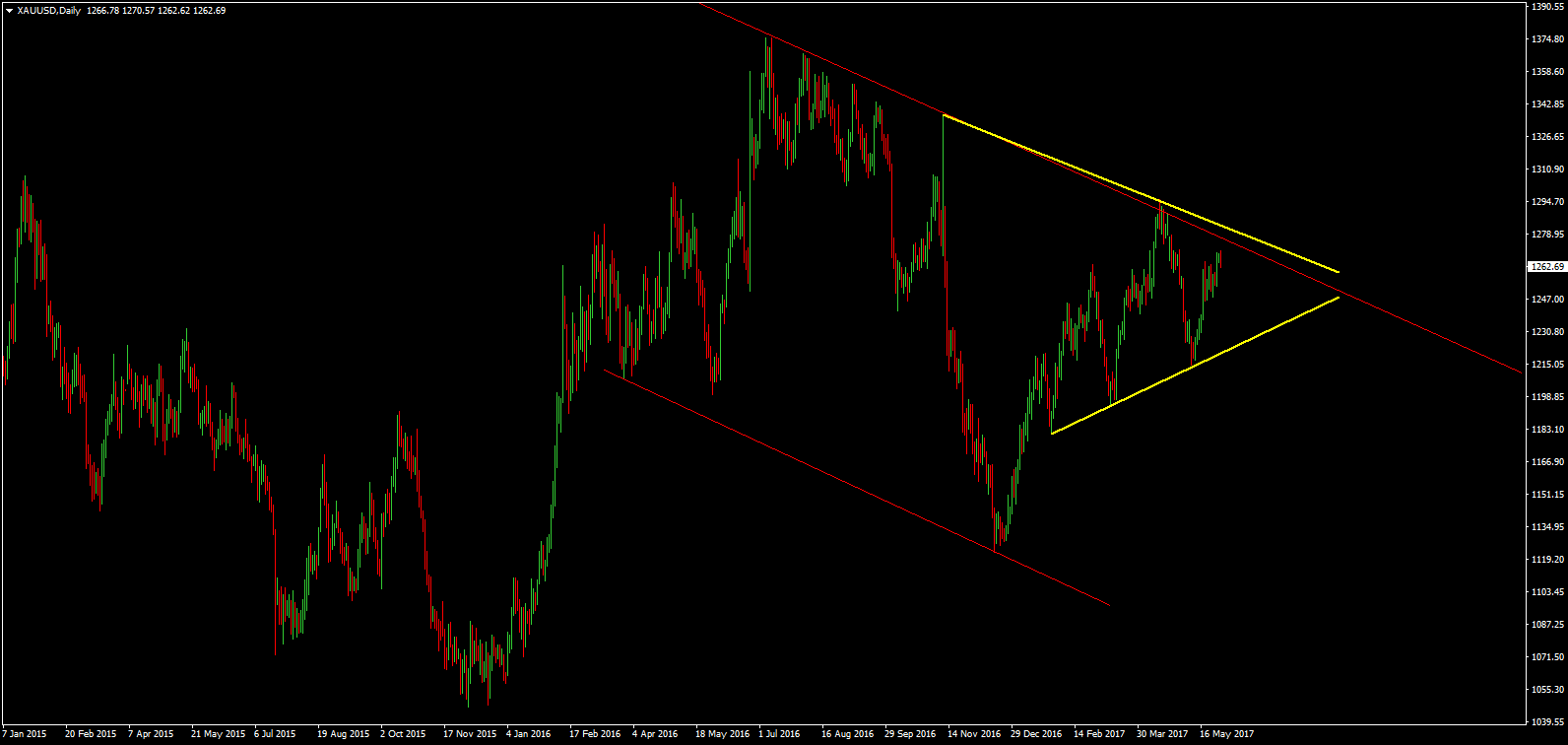
FOMC Minutes Support Rate Hike “Soon”
The minutes of the latest FOMC meeting revealed that the Fed feel it will “soon be appropriate” to raise rates again if “economic information came in about in line” with current forecasts. Investors have been steadily increasing their rate hike expectations as the Fed have turned more hawkish and current market pricing for a June hike stands around 80%.
However, the coming hikes are still contingent on a pickup in economic data. Indeed, despite the hawkish forecasts, the minutes also showed that the Fed feel it would be “prudent” to wait for data to confirm that the recent slowdown is only transitory.
Why Is Gold Still Rising?
Gold prices had been moving steadily higher over 2017 with XAUUSD peaking at 1295.61 in May before dropping back as rate hike expectations began to build. However, price steadied in early May and have once again started to push higher. So, if the FOMC minutes are supporting the view that a hike is imminent, why is Gold still trading on a firm footing.
Factors Supporting Gold
Firstly, it is important to note that the market response to a Fed rate-hike won’t necessarily be USD bullish. Following the Fed’s initial hike (of this tightening cycle) in December 2015, Gold prices rallied strongly as the US Dollar came under heavy selling pressure.
Similarly, following the Fed’s second hike in December 2016, gold price once again saw strong demand as the US Dollar was sold off. So why is this? Well, the main driver of how the market responds to Fed rate hikes is linked to the level of expectations in the market ahead of the rate hike and the forward guidance that the Fed gives.
In each case, market expectation ahead of the hike has been extremely elevated and also in both cases the Fed has lowered its forward guidance. As such, both hikes have been deemed “dovish hikes” whereby the Fed raises rates but lowers its forecasts, so they are less hawkish than they were before. This dynamic typically favours gold over the US Dollar as traders react with disappointment and also, sensing uncertainty from the Fed, find it more prudent to invest in gold instead of the US Dollar.
With market expectations around 80% heading into the June meeting, there is plenty of room for disappointment and so in many traders mind, the better risk:reward trade is to stay long gold. Furthermore, even if the Fed do raise rates, they are likely to reiterate that the tightening path is to remain slow and gradual and data dependant, which for many traders simply means that the Fed are unsure about when they will raise next, again favouring gold over the US Dollar.
Another factor that has been supporting gold prices is the rising level of geo-political tensions that we have been seeing over recent months. The US air-strike on Syria, the growing threat of a North Korean missile strike as well as terrorist attacks across Europe, as well as in the US, have all contributed to maintain a safe-haven bid in Gold as investors look to protect their capital amidst rising global uncertainty. The situation with North Korea has been particularly damaging to global risk sentiment given President’s Trump’s volatile responses which have often included issuing threats over the social media site Twitter.
One further factor that supports higher prices in the precious metal is that of the impact that President Trump’s proposed trade policies are having on both the US Dollar and global risk sentiment. While the President has yet to implement any major trade policies other than a tariff on Canadian lumber (and a forthcoming tariff on Canadian dairy products also), markets are wary of the protectionist policies that Trump advocated over his campaign. Trump’s plans to renegotiate or withdraw from major trade partnerships as well as implementing heavy tariffs on major trading partners have all contributed to a great deal of uncertainty among investors.
Past periods of US protectionism have weighed on the US Dollar while supporting gold as once again investors flock to the safe haven asset. The potential for protectionist trade policies from the President means that gold is likely to retain its safe haven bid even in the event of a US rate hike.
Technical Perspective:

There are currently two key technical patterns in gold. The first, and longer term pattern, is the bearish channel which can be seen in red. The upper channel line stretches back as far as 2011 while the lower channel line started in early 2016. This pattern suggests a bearish bias. However, in the near term, there is the potential for a change in direction as the market has entered a contracting triangle, shown in yellow. This classic technical pattern suggests a waning of momentum and a contraction in volatility and typically precedes as a strong breakout. While the longer term picture suggests a potential bearish break out, for the reasons listed above, traders should be wary of the potential for a bullish breakout and a change in direction for gold.